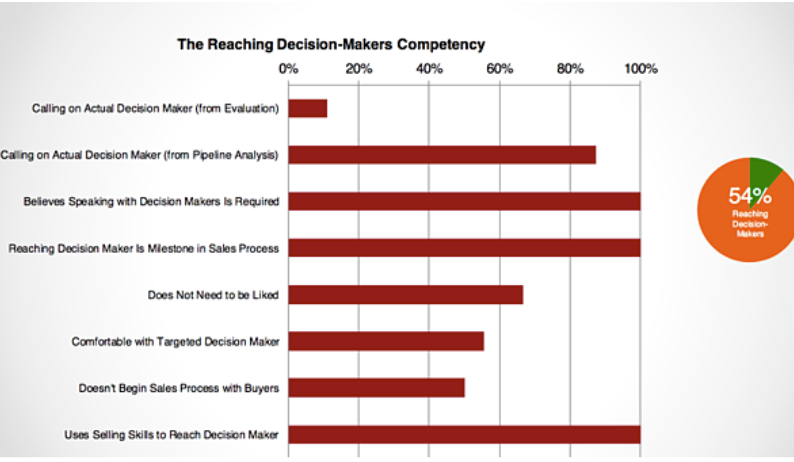A referral is the best way to get a meeting with the decision maker.
There are two parts to the sales process:
-
- Part One: Getting meetings with decision makers
- Part Two: Everything that happens after that
Referrals help you ace Part One and set you up for success in Part Two. That’s an over-simplification, I know, but it’s the easiest way for people to understand the power of a referral introduction. You get an introduction to your prospect, and you get a meeting with the decision maker. If you don’t get the meeting, Part Two doesn’t matter.
Why It’s So Hard to Reach Decision Makers
The biggest challenge for sales teams is seller access, according to Gartner’s recent report, The Chief Sales Officer’s Leadership Vision for 2021. Salespeople continually struggle with reaching B2B decision makers. They rely on what they’ve done before, which is cold calling and sending cold emails, and decision makers don’t want either.
Some salespeople fool themselves into believing what I call the “warm call fantasy.” They believe a call isn’t cold because it’s a marketing-qualified lead, because the prospect downloaded a whitepaper, or because they have a mutual connection on LinkedIn.
Wrong! Without an introduction, your outreach is ice cold. “Cold” means your prospect doesn’t know you and doesn’t expect to hear from you. Your outreach is either cold or hot. There’s no such thing as a “warm call.”
Attempting to reach decision makers you don’t know on social media is just as pointless. Social sites offer a great way to identify mutual contacts who could provide referrals, but before you start name dropping, reach out to your referral source and make sure that person actually has a relationship with your prospect. Explain why you want to get a meeting with the decision maker, and learn about your prospect’s business and issues. Your referral sources can provide intel that you won’t get anyplace else. Then, ask for an introduction.
When you receive a referral introduction, you breeze past gatekeepers and walk right into meetings with your prospects. Without the introduction, you’re just another cold caller, and cold callers don’t usually get to talk to B2B decision makers.
New research from Dave Kurlan and The Objective Management Group (OMG) backs up my claims. Dave summarizes their findings in this post: Discovered: Data Reveals the Biggest Obstacle to Closing More Sales. He explains:
“When salespeople successfully reach the actual decision makers, opportunities move through the pipeline and reach the closable stage, often resulting in a win. However, MOST salespeople are NOT reaching the actual decision makers and those are the opportunities that lose traction and/or result in a loss.”
OMG’s research shows that an average sales force possesses 54 percent of the sales competencies needed to reach decision makers, but only 13 percent of salespeople are particularly good at it.

Worse yet, only 10 percent of salespeople are consistently reaching decision makers. Dave writes:
“Remember, for the most part, these are salespeople who believe it’s important to reach the decision maker, have that as a milestone in their sales process, have the sales skills to reach decision makers, but still fail to reach the decision makers … Clearly, this is not the only problem that sales organizations are facing by a long shot. However, this data shows that if they could fix just one thing today, the consistent ability to reach decision makers would make a huge difference.”
What’s Standing Between Sellers and B2B Decision Makers
I don’t blame salespeople for not being able to get a meeting with the decision maker. I blame outdated lead-gen strategies, metrics, and leadership.
Have you ever been in a situation where you were hired for a specific job, but you weren’t given the requisite tools to be successful? My answer is yes, and I bet your answer is yes as well. In the past, new salespeople were given a desk, a phone, and a phonebook, and that was about it. Today they’re given a desk (sometimes), a mobile phone, and a password. Either way, it’s never been enough.

(Image attribution: fauxels)
Sure, new hires get product training and information about how great their company is, but they have no clue how to reach decision makers quickly, build trusting relationships with prospects from the get-go, and learn inside info no one else gets. We can’t be surprised when these folks don’t get meetings at the level that counts. No one ever taught them how to ask for referrals and get introductions to prime prospects.
3 Tips for Reaching the Decision Maker
Sales leaders, do you want to change the game for your reps, get only qualified leads in the pipe, and enroll your clients as your extended sales team? Try these tips for reaching the decision maker:
- Make referrals a process and a priority: Referral selling must be your #1 business-development outreach. “Priority” is a singular word. Referral selling is either the priority, or it’s not. Referrals must be tightly integrated into your sales process and reinforced with rewards and recognition for your referral programs to scale.
- Create metrics and accountability: Referral success can be tracked and measured just as easily as results from cold calling, direct mail, and advertising. The trick is to focus on leading indicators like referral activities, not just lagging indicators like revenue.
- Change your perspective on referrals: Referral selling is hugely personal. Our reputation is on the line. Most salespeople are uncomfortable asking for referrals—especially from their clients. They fear doing so might jeopardize their relationship. They say it feels pushy and worry the other person will say “no.” (Fear of rejection is much stronger when salespeople talk to people they know, versus cold calling strangers.) With training and practice, reps begin to understand that referrals aren’t favors or impositions. They’re how deals get done.
The definition of insanity is doing the same thing over and over, and expecting different results. If you’re challenged with seller access and reaching decision makers, isn’t it time to try something new? Build a referral culture, give your team the tools and skills to ask for referrals, and measure and manage referral selling.
Schedule a call with me, and I’ll share prospecting best practices I’ve learned the past 25 years. You might decide to work with me, or not, but I guarantee you’ll walk away with fresh ideas and action steps. Contact me at joanne@nomorecoldcalling.com, and we’ll schedule a call.
(Featured image attribution: krakenimages)

